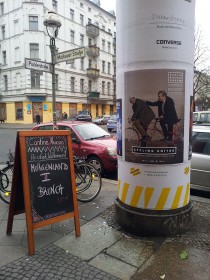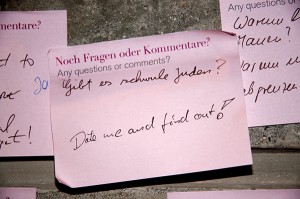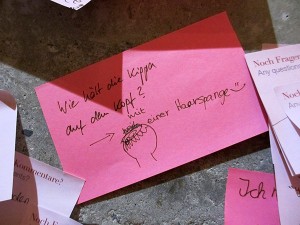Pessach is approaching – the festival of exodus and freedom. This year, there is less talk of having the festive meal at large community gatherings. It is obvious, although unspoken, that smaller gatherings in the home make more sense. We are becoming alienated from our community centers through fear. Keep a low profile. Don’t speak Hebrew on the streets. Some people are removing the mezuzah from their front doorposts, a traditional object that visibly identifies a Jewish household. There is a mood of caution and nervous apprehension.
How did it get to this point?

Advertisement with Imam Ferid Heider and Rabbi Daniel Alter for the “Cycling Unites”-Critical-Mass-Tour in Berlin on 22 March 2015, photo: Michal Friedlander
June, 2014
A drunken man rolls slowly off the train platform and plops onto the tracks at Friedrichstrasse station. Around sixty people witness the moment and look away, hoping that someone else will solve the stinky, awkward problem. And so it was. An Italian and an Israeli jumped down to haul the semi-conscious man to safety. The passengers walked around the startled little group, pressing forward to make the oncoming train.
July 2014
Dinner party small talk. The discussions nearest me are taking a more political turn and I am just not in the mood to talk about Israel. Too late. The young man next to me asks if I saw the recent pro-Palestinian demonstration on the Kurfürstendamm? He becomes very still and lowers his voice. → continue reading
Answer: “Date me and find out!”

Question in the exhibition “The Whole Truth”: “Are there gay Jews?” Answer: “Date me and find out!”
© Jewish Museum Berlin, photo: Anina Falasca
Our special exhibition “The Whole Truth… everything you always wanted to know about Jews” is based on 30 questions posed to the Jewish Museum Berlin or its staff over the past few years. In the exhibition, visitors have their own opportunity to ask questions or to leave comments on post-it notes. We answer some of these questions here in our blog. To address the subject of homosexuality and Judaism, we spoke to a gay Jew and had the following exchange: → continue reading
“How does a kippah stay on?”
Our current special exhibition “The Whole Truth… everything you always wanted to know about Jews” is based on 30 questions posed to the Jewish Museum Berlin or its staff over the past few years. In the exhibition, visitors have their own opportunity to ask questions or to leave comments on post-it notes. Some of these questions will be answered here in our blog. This month’s question is: “How does a kippah stay on?”

“How does a kippah stay on?”
© photo: Anina Falasca, Jewish Museum Berlin
If a non-Jew tries on a kippah, it usually falls off. This isn’t fair, but let’s examine the circumstances more closely. When tourists visit the Jewish cemetery in Prague, all men are asked to wear a kippah. Those who travel kippah-free are requested to don a blue, sharply-creased, circular piece of paper. The precarious kippah is inevitably subjected to the winds off the Vltava and flutters away. Comparably, a non-Jewish man attending a synagogue ceremony such as a marriage or Bar Mitzvah, will usually be requested to wear a kippah. Here, a stiff yet slippery synthetic satin kippah is ubiquitous. No guest stands a chance.
What then is the secret to making a kippah stay on? → continue reading


